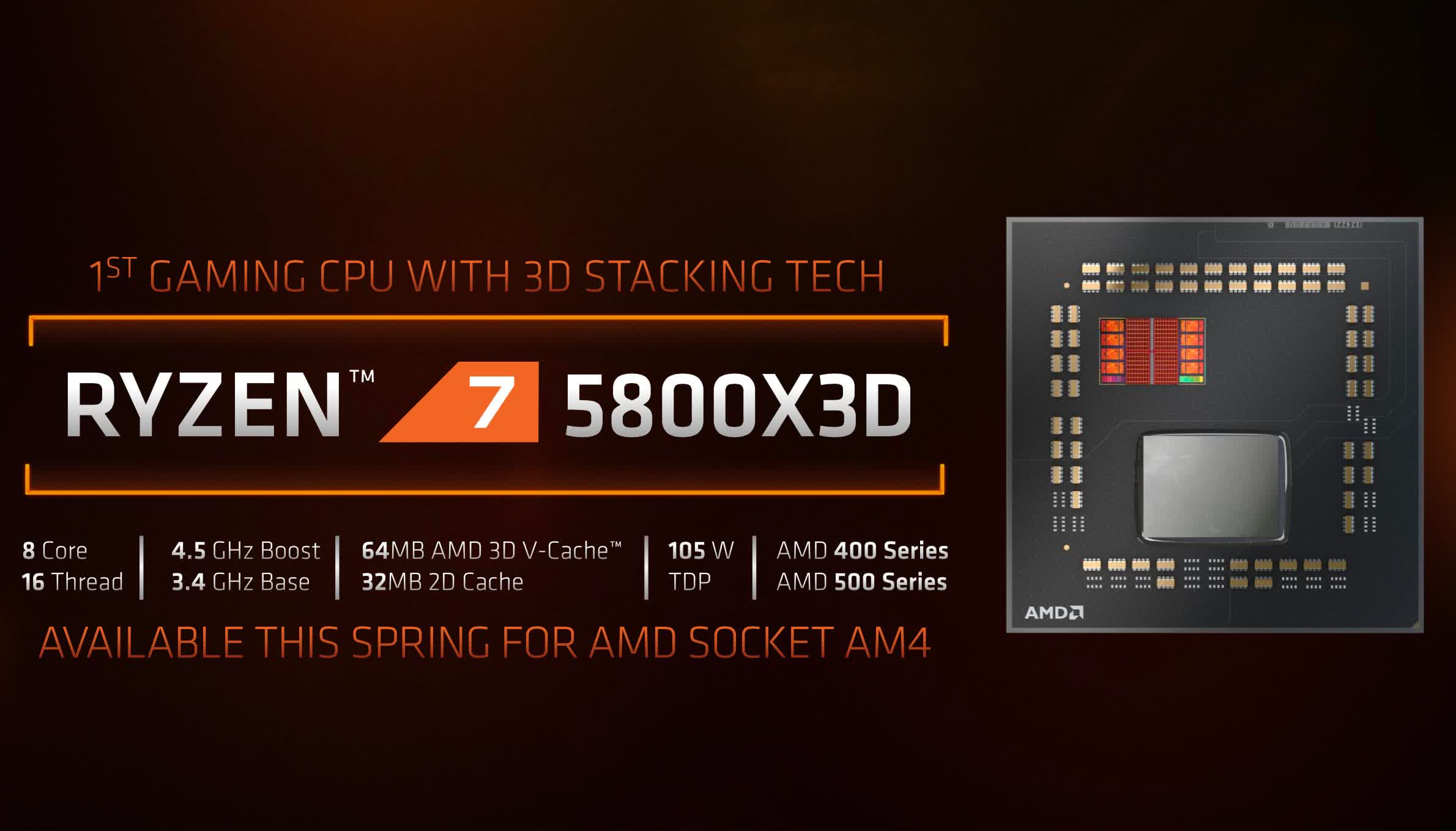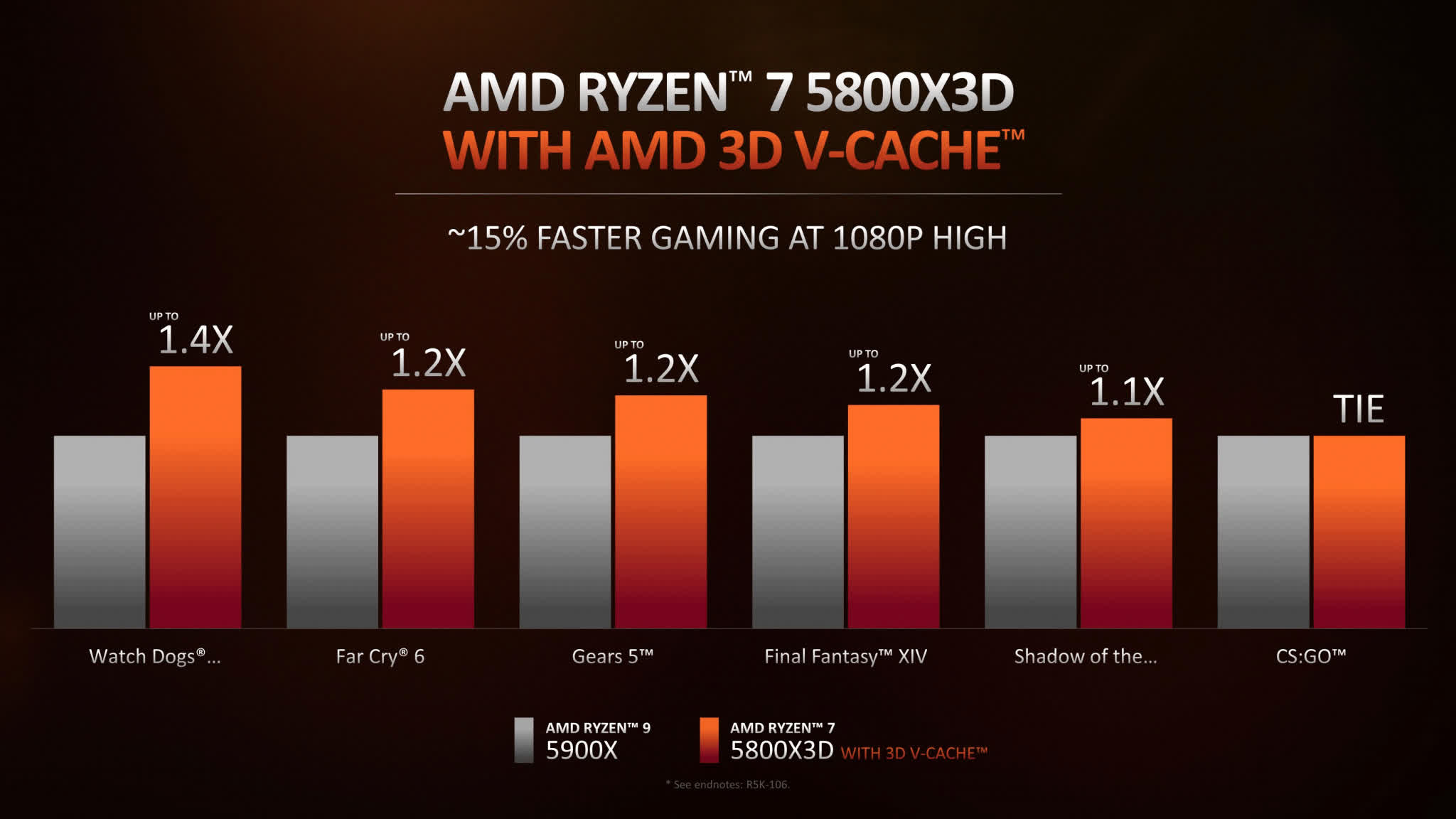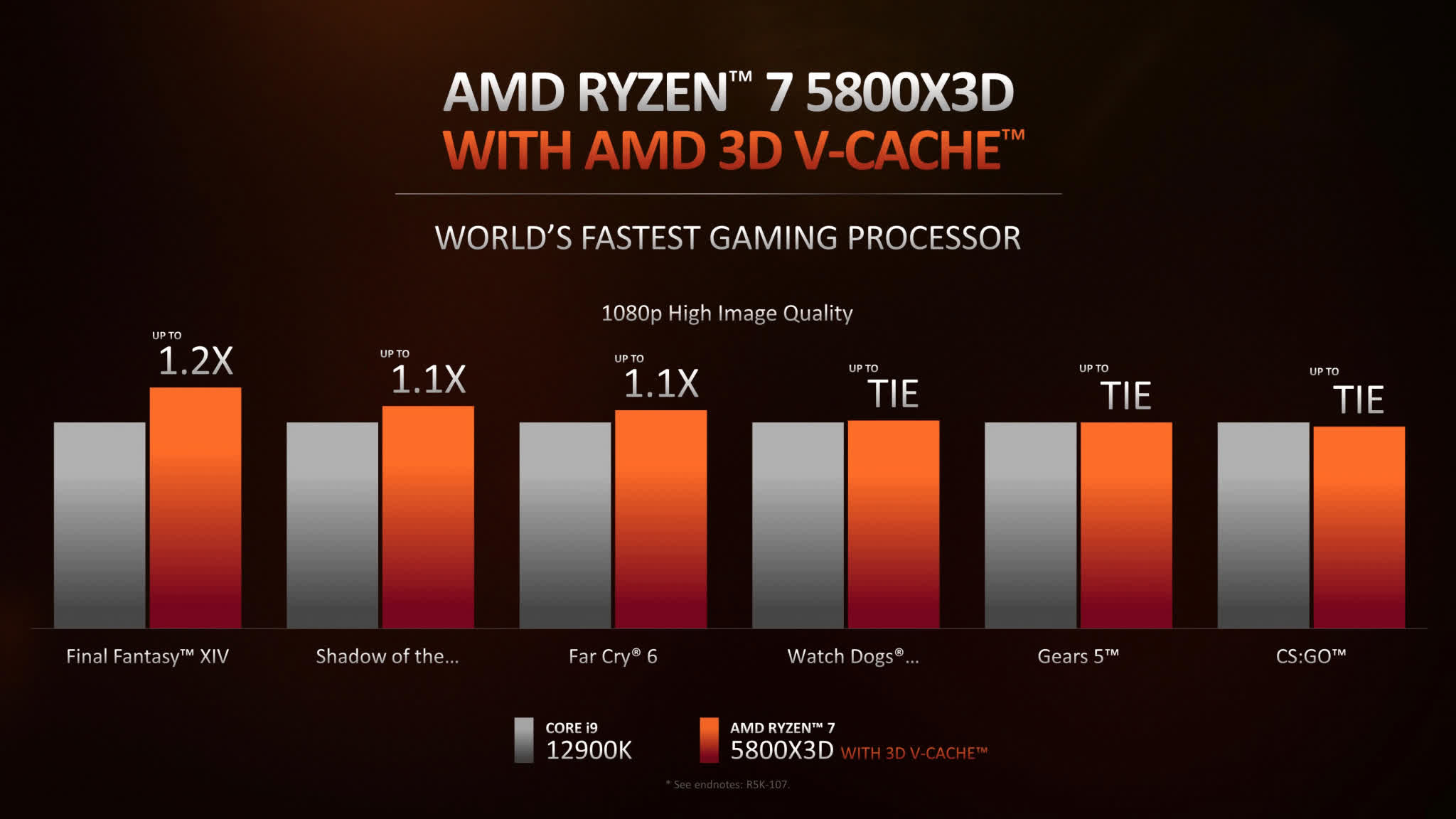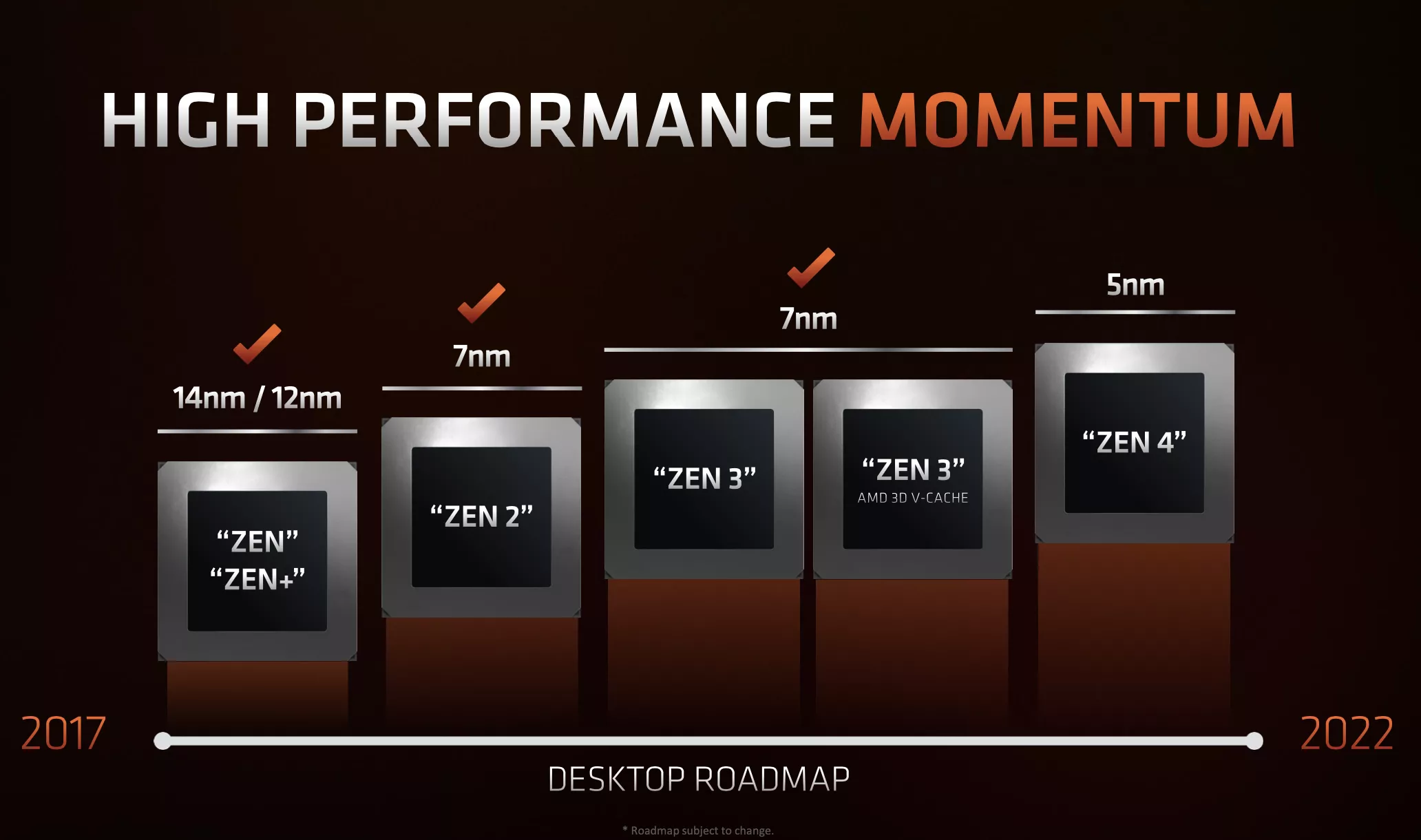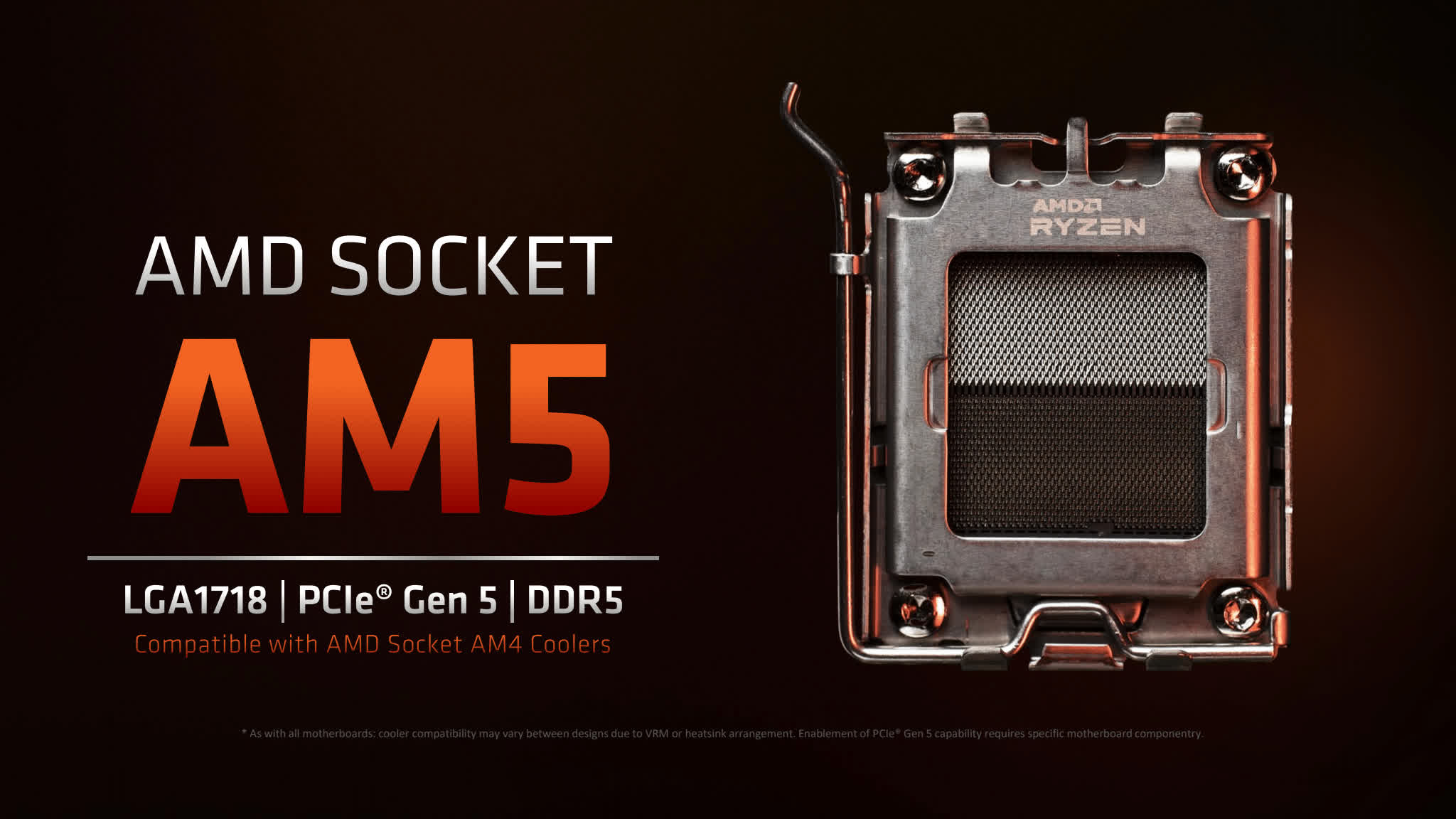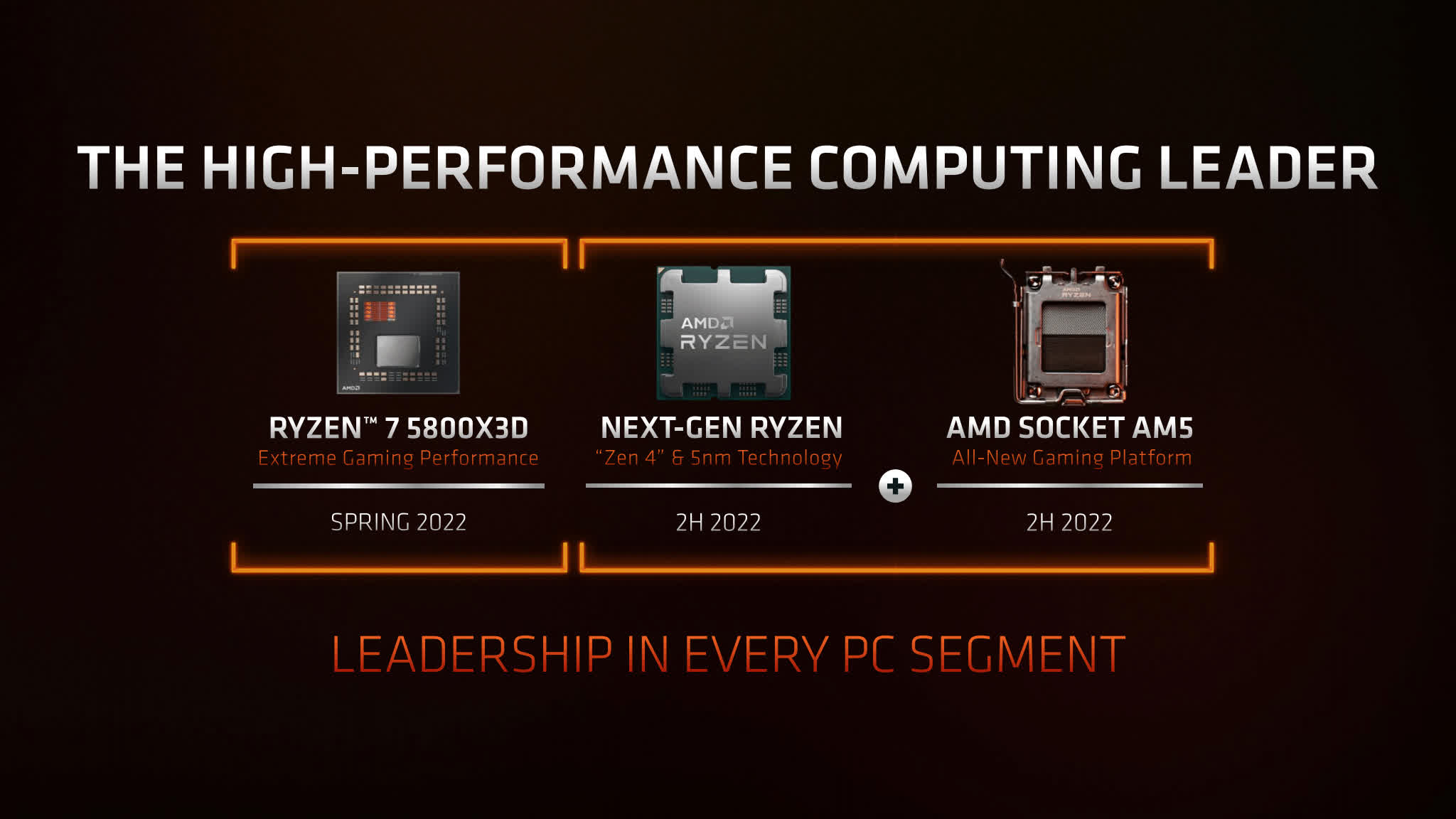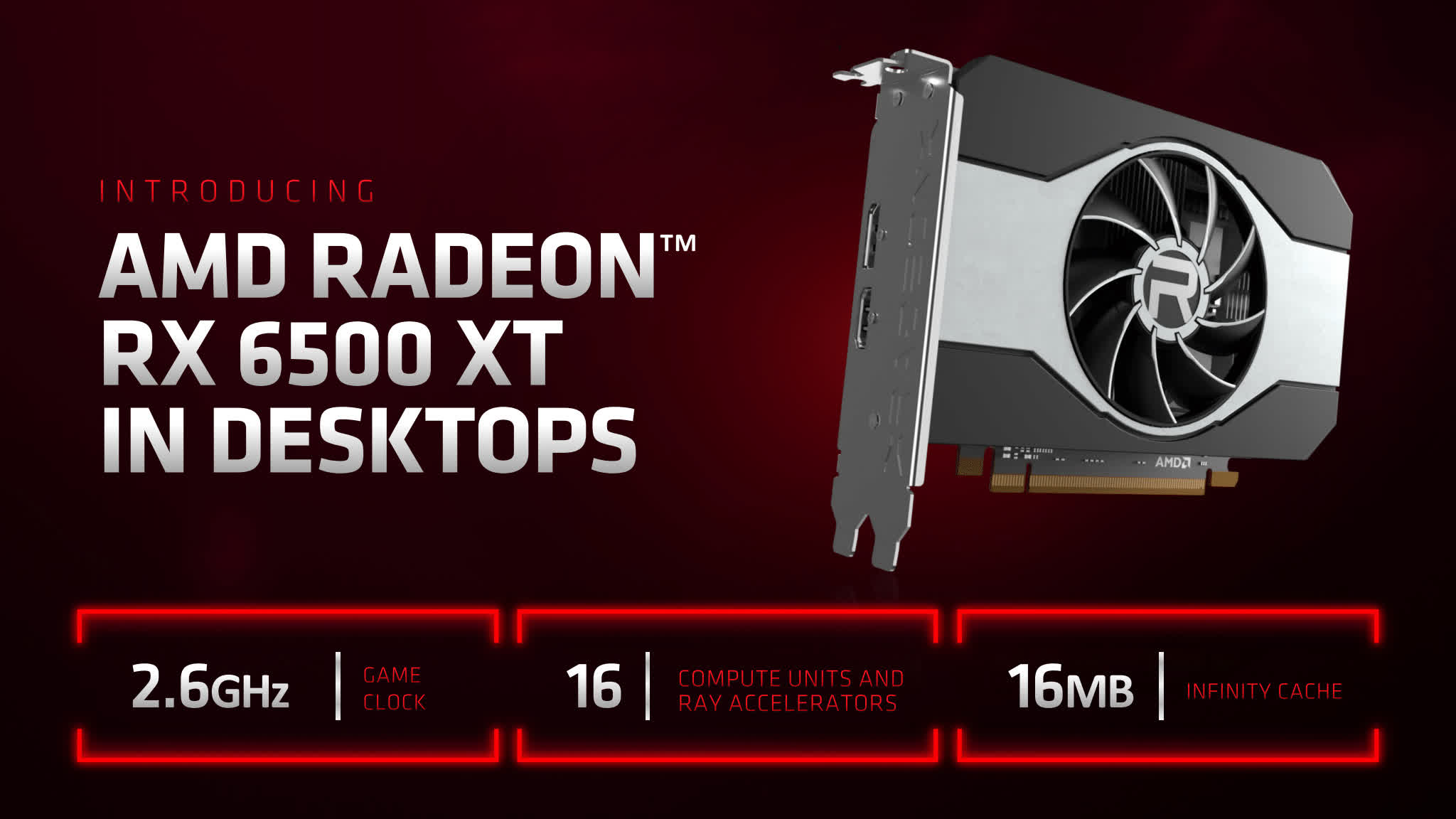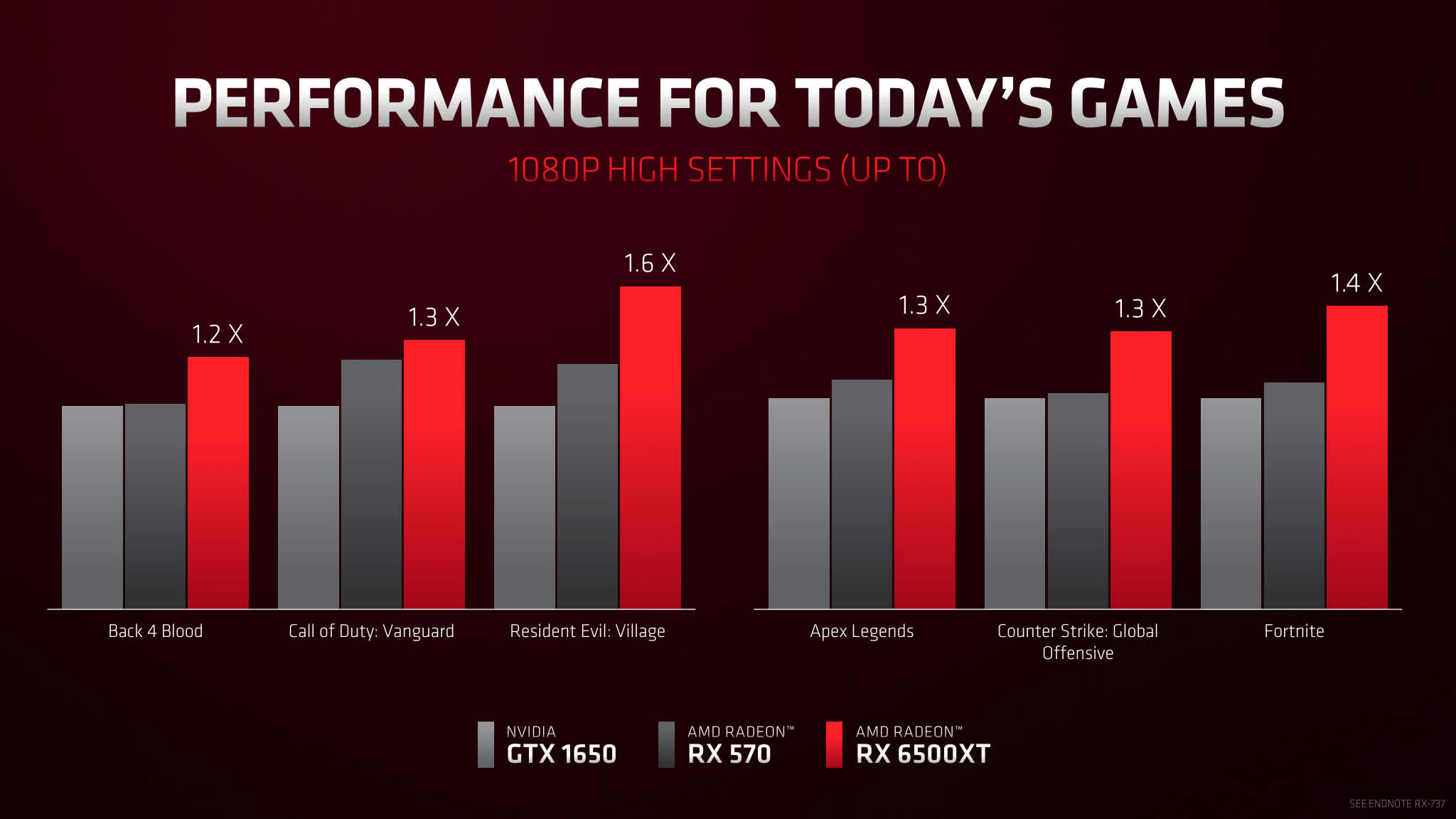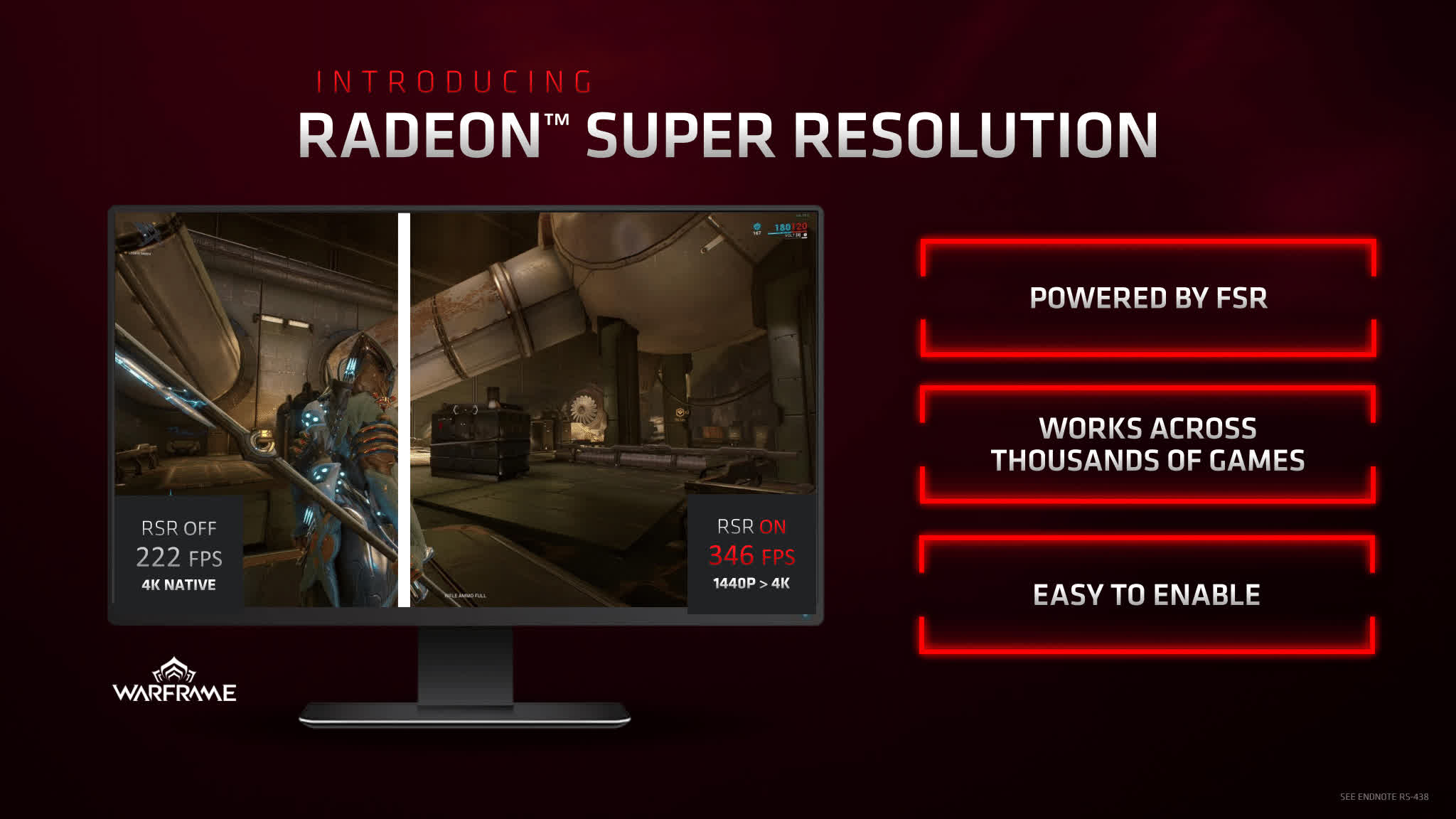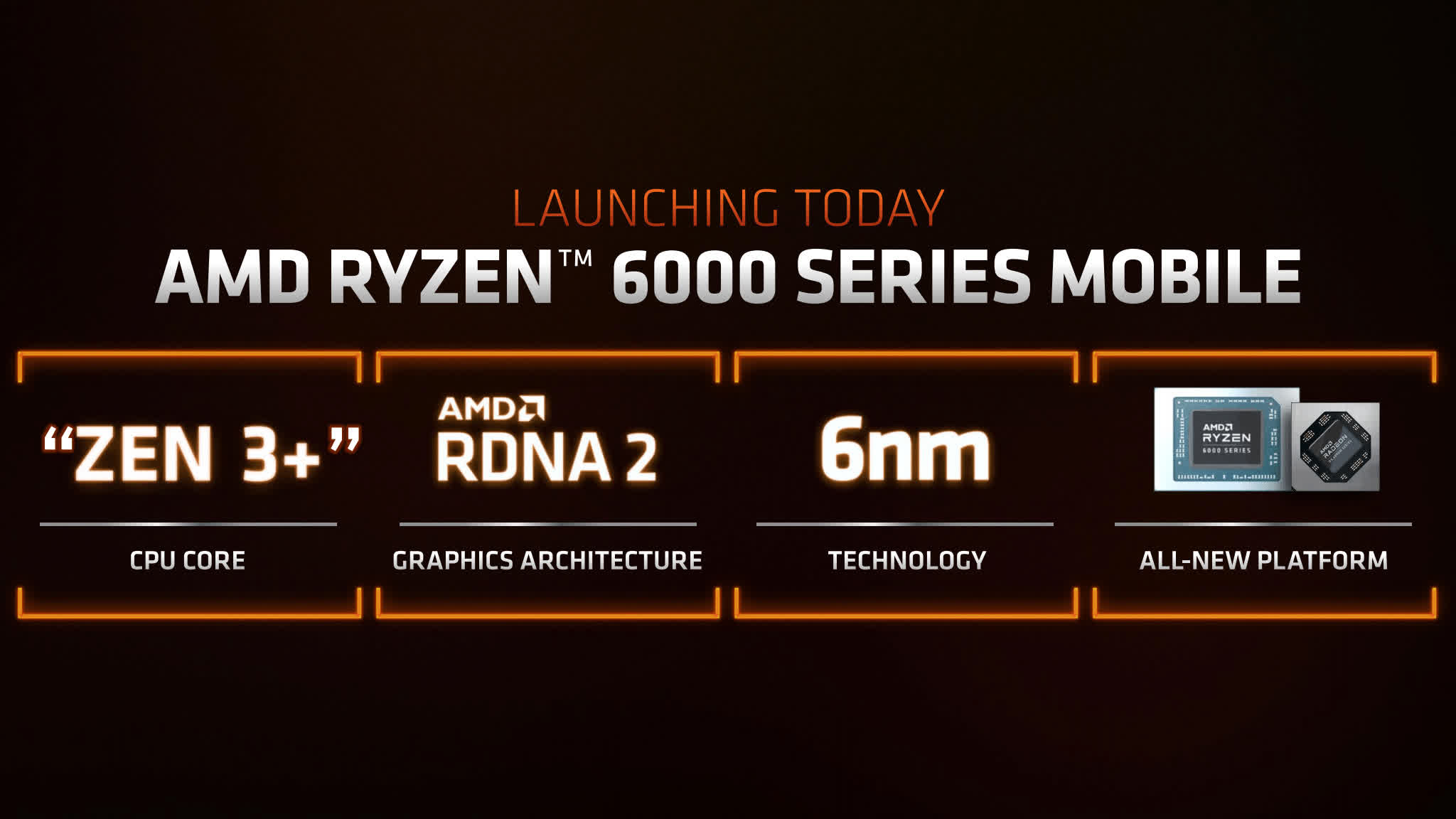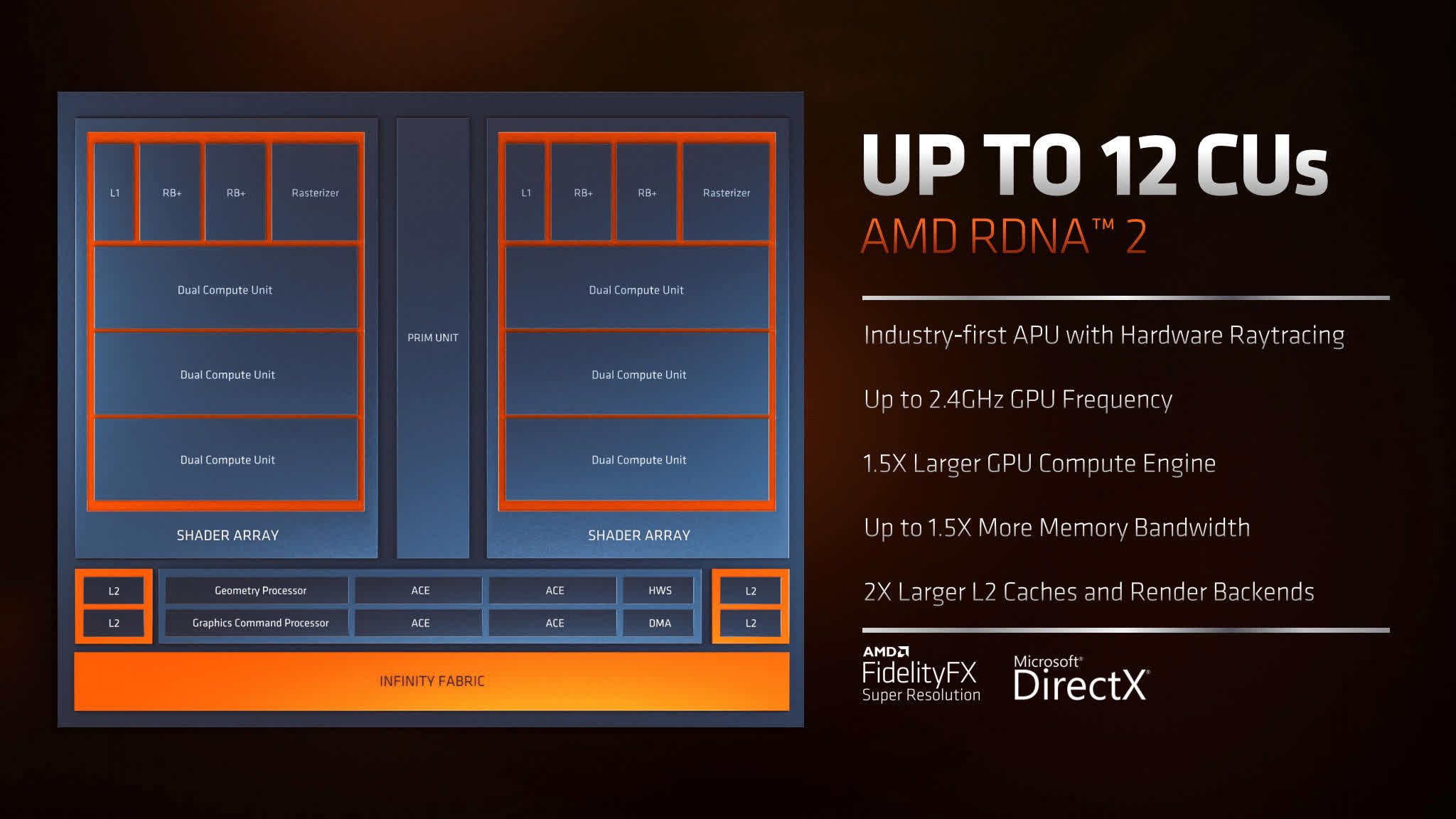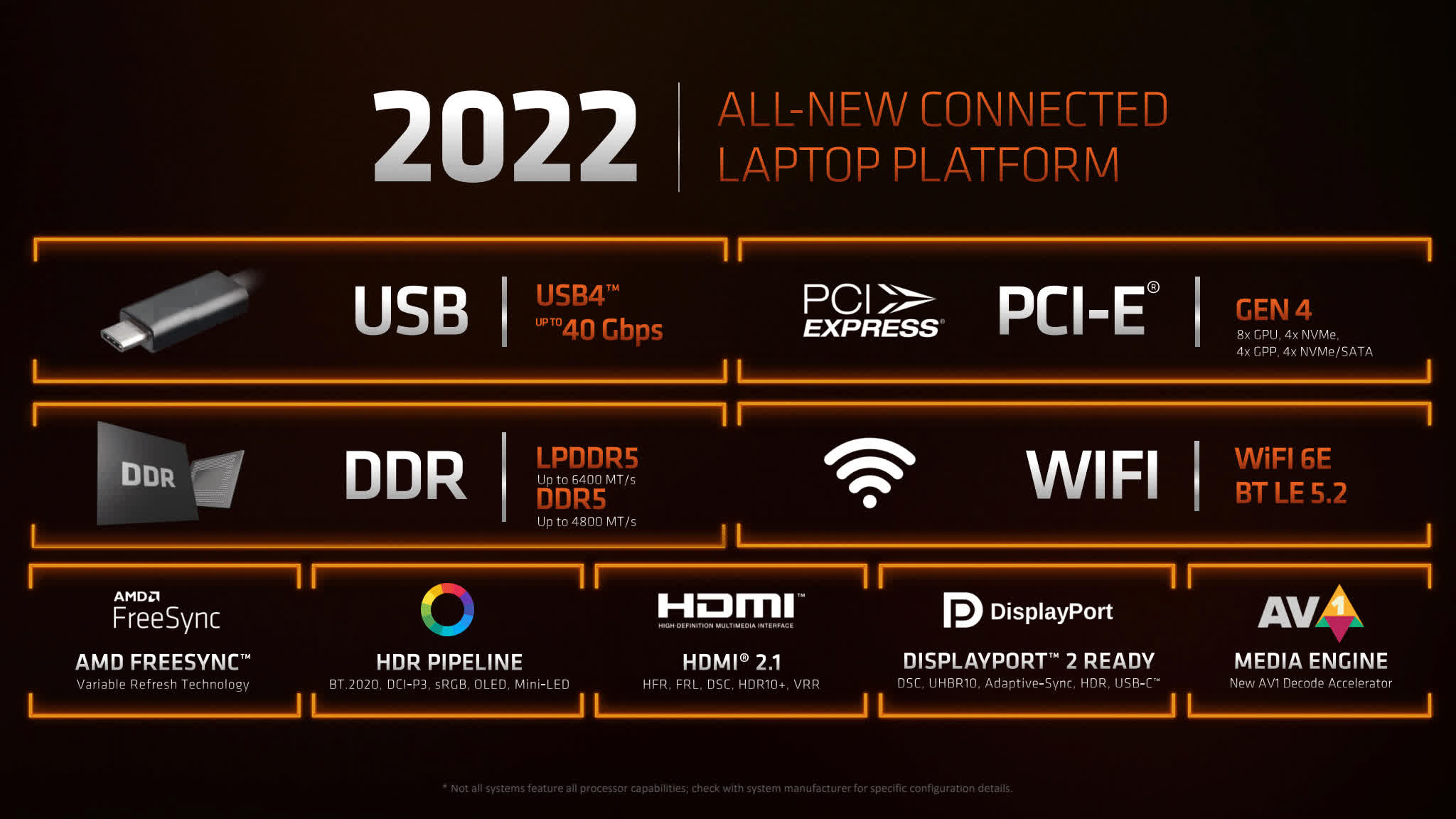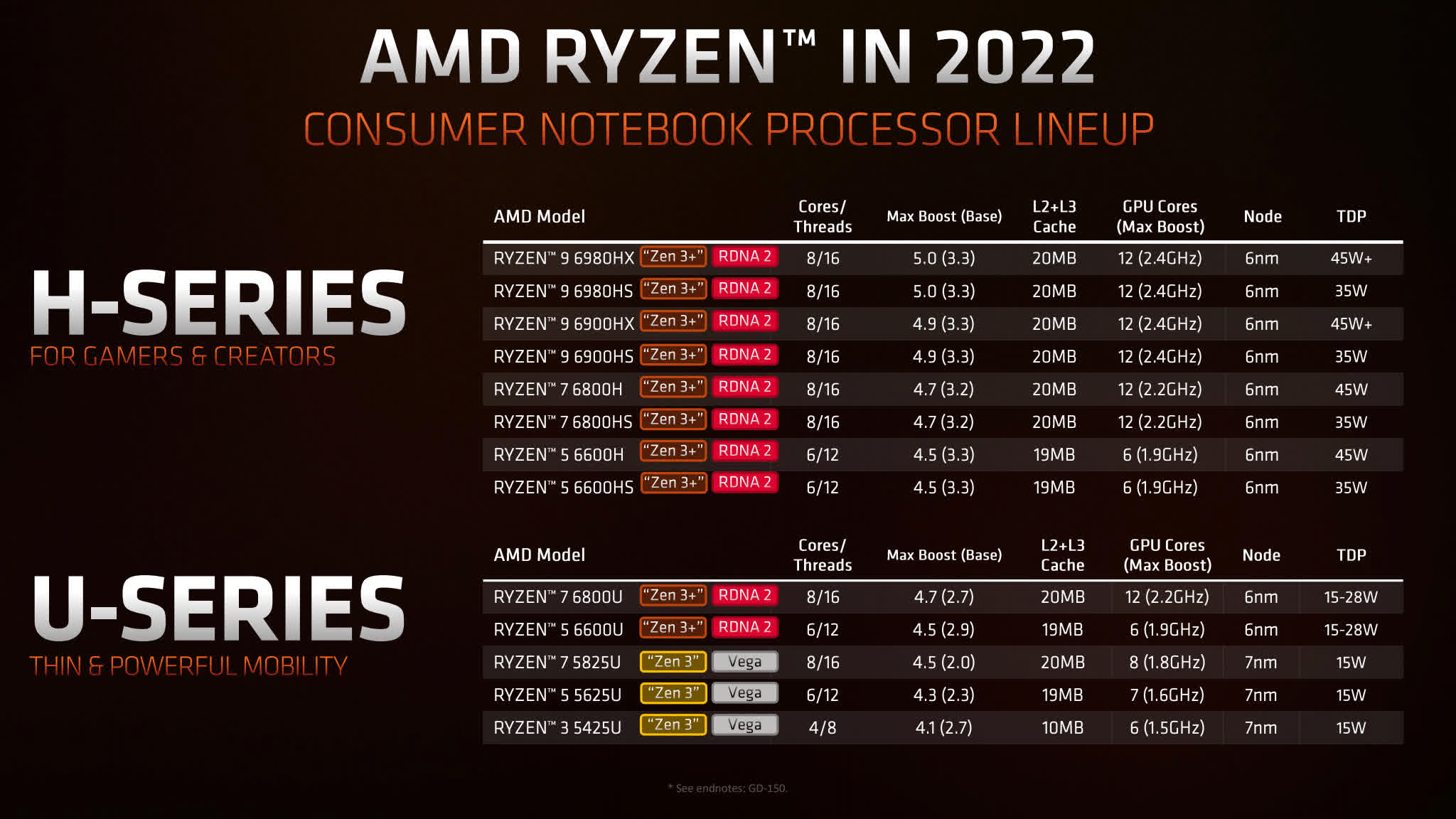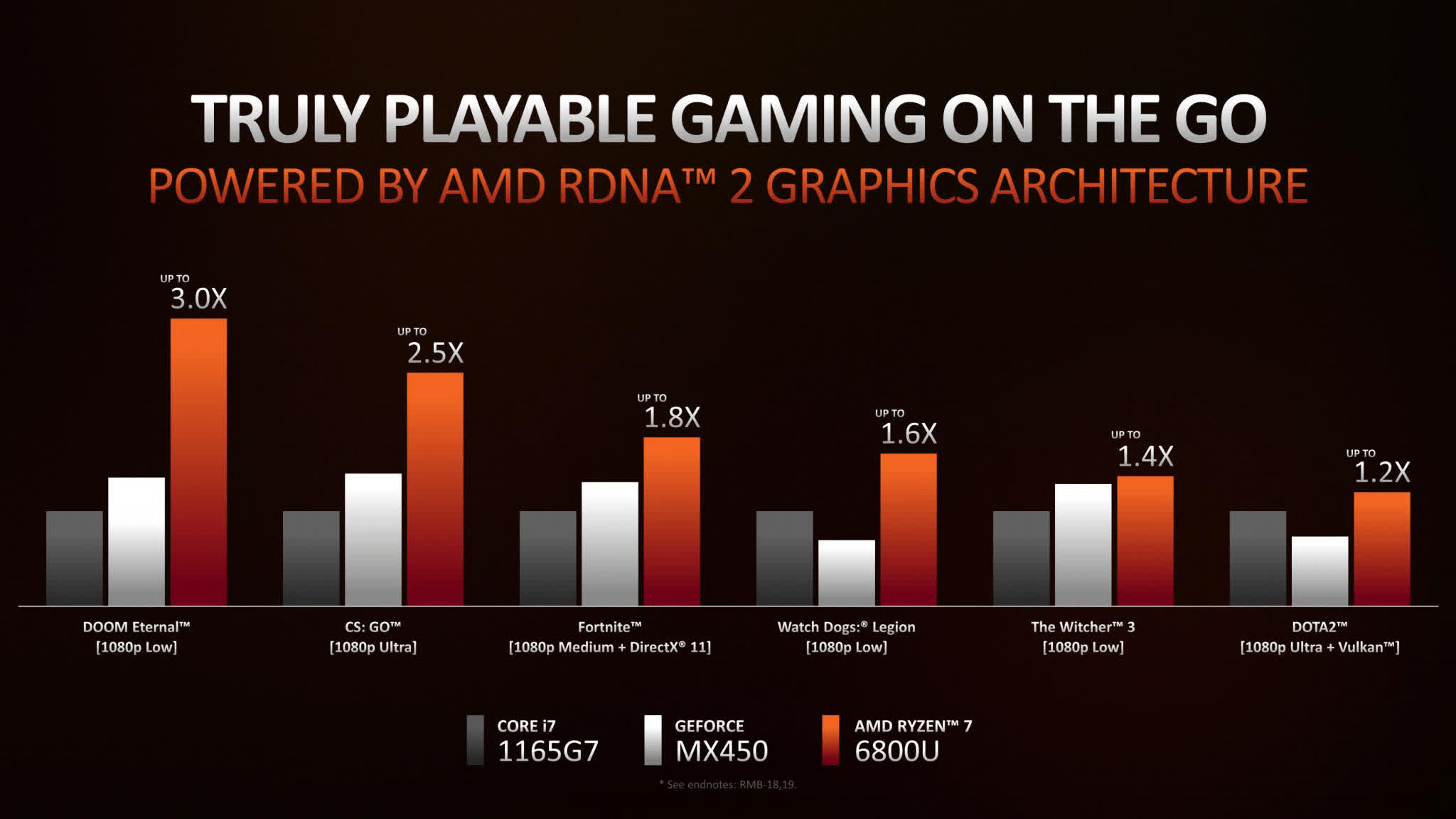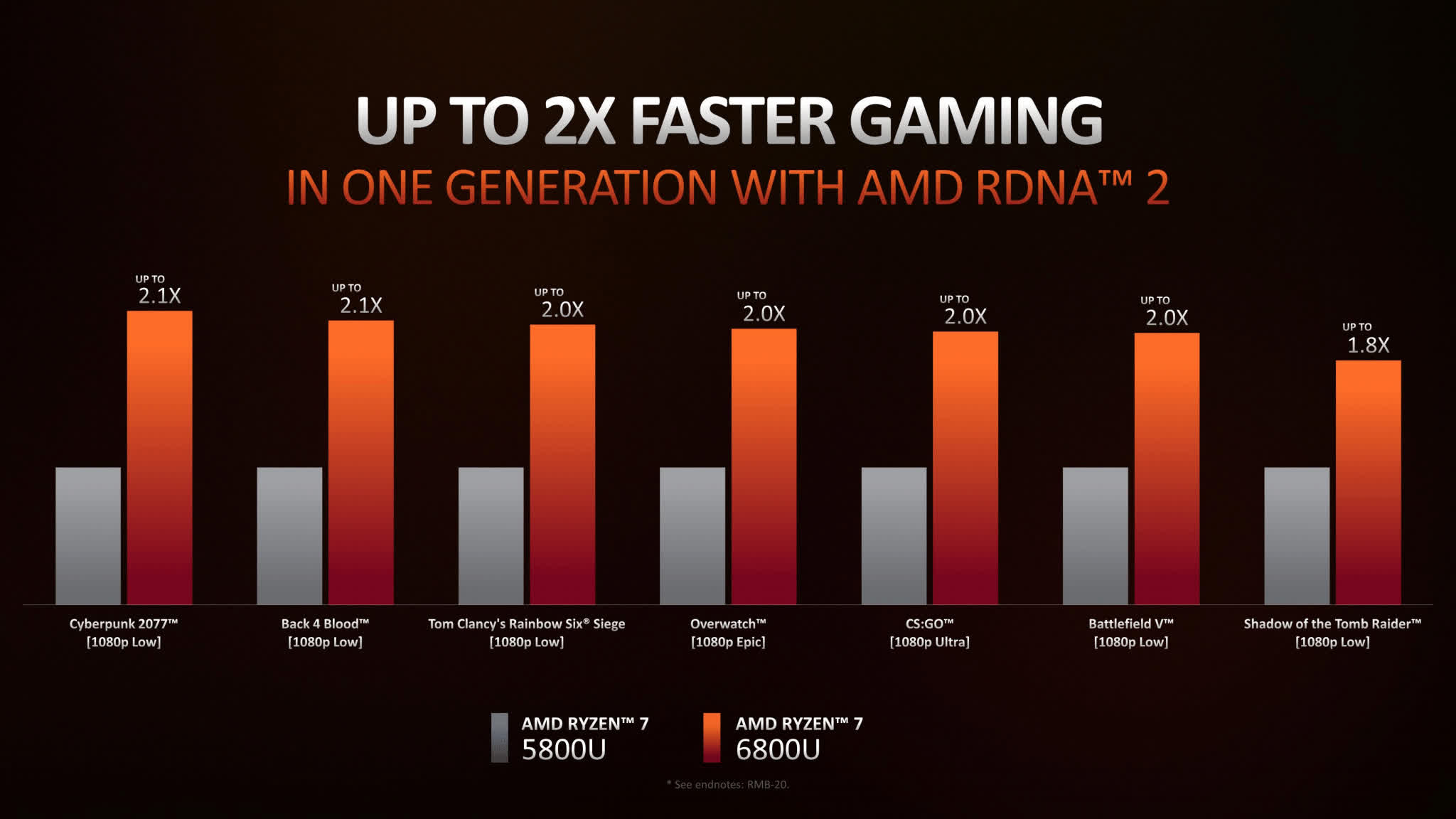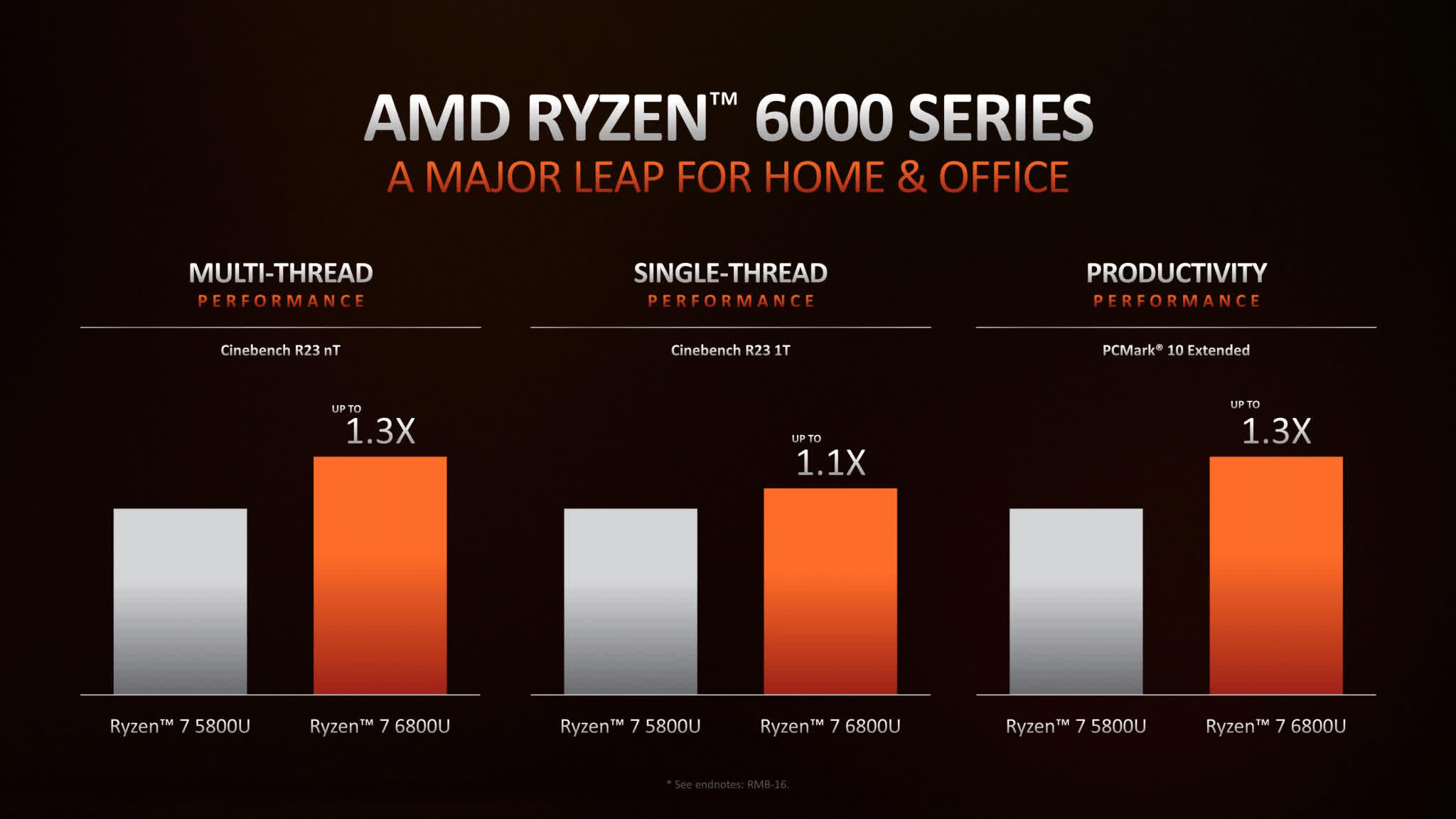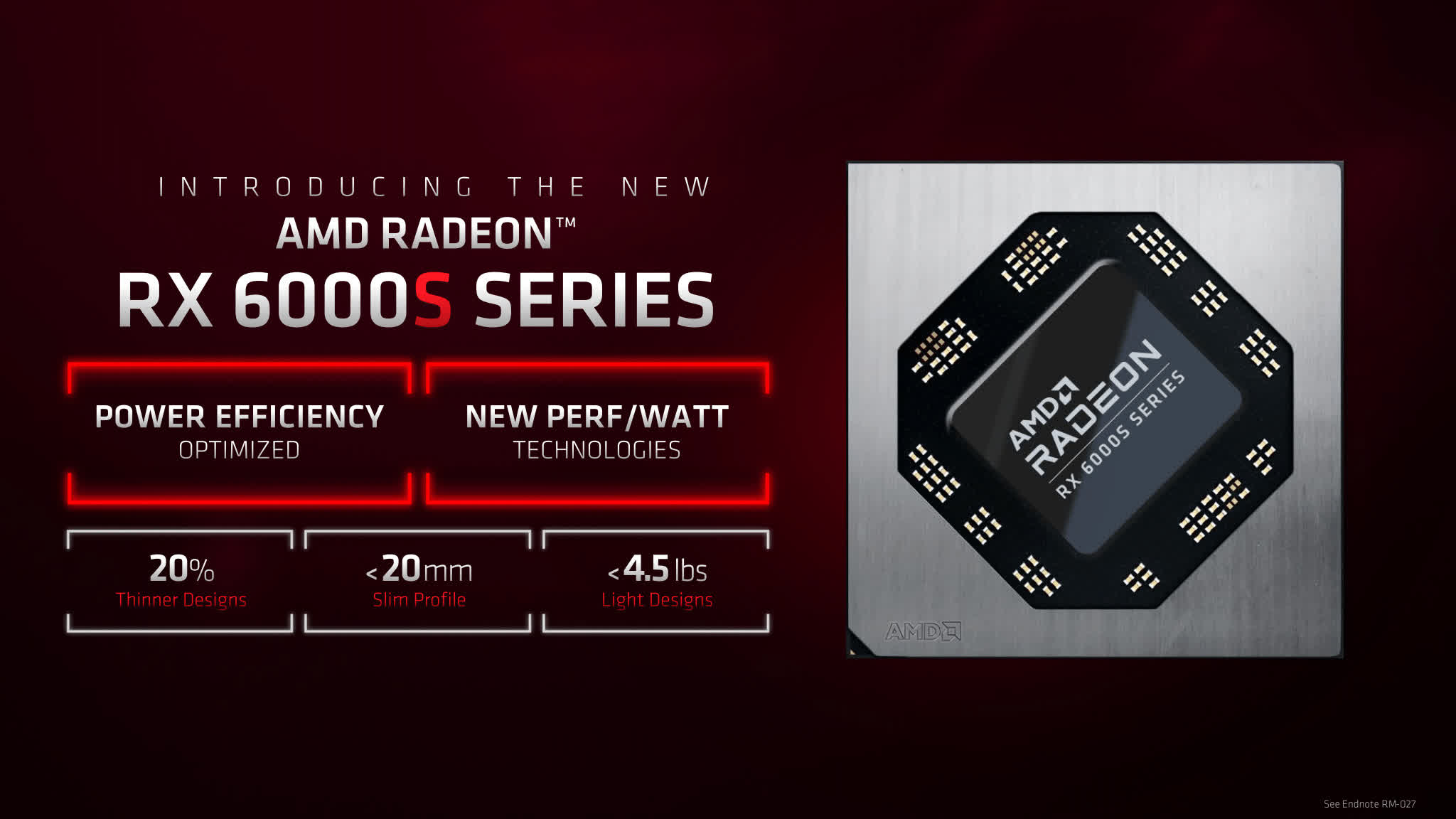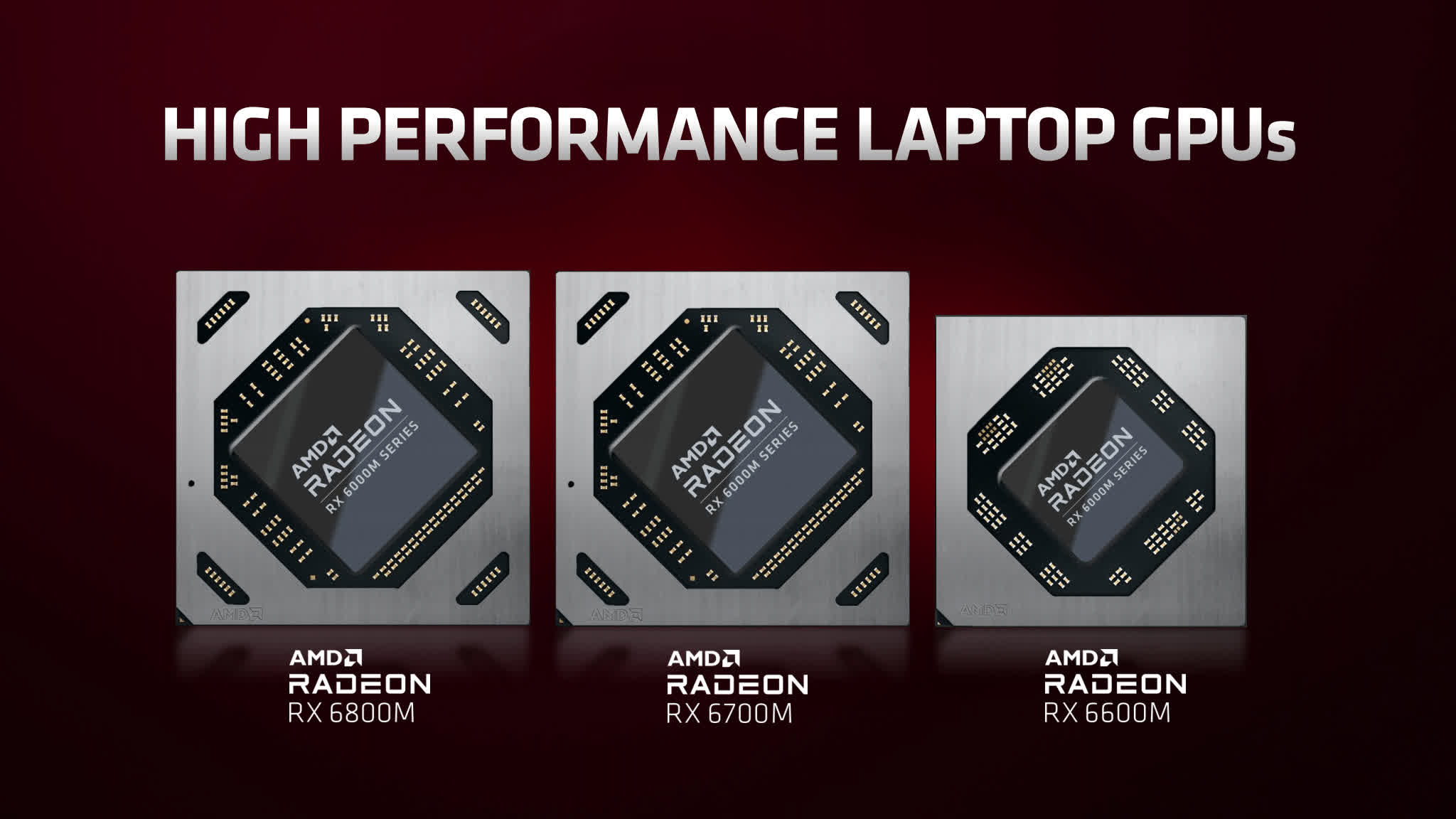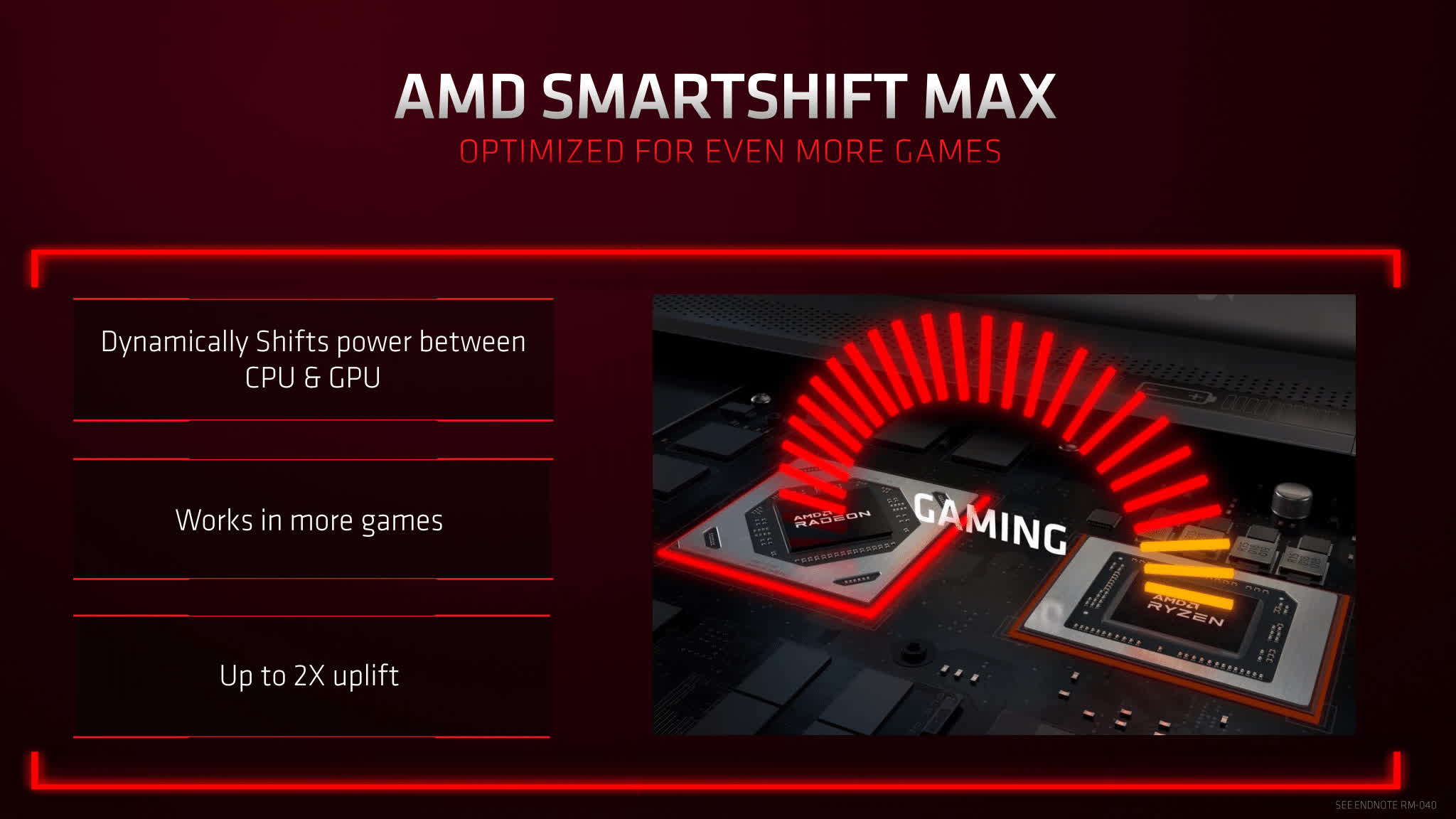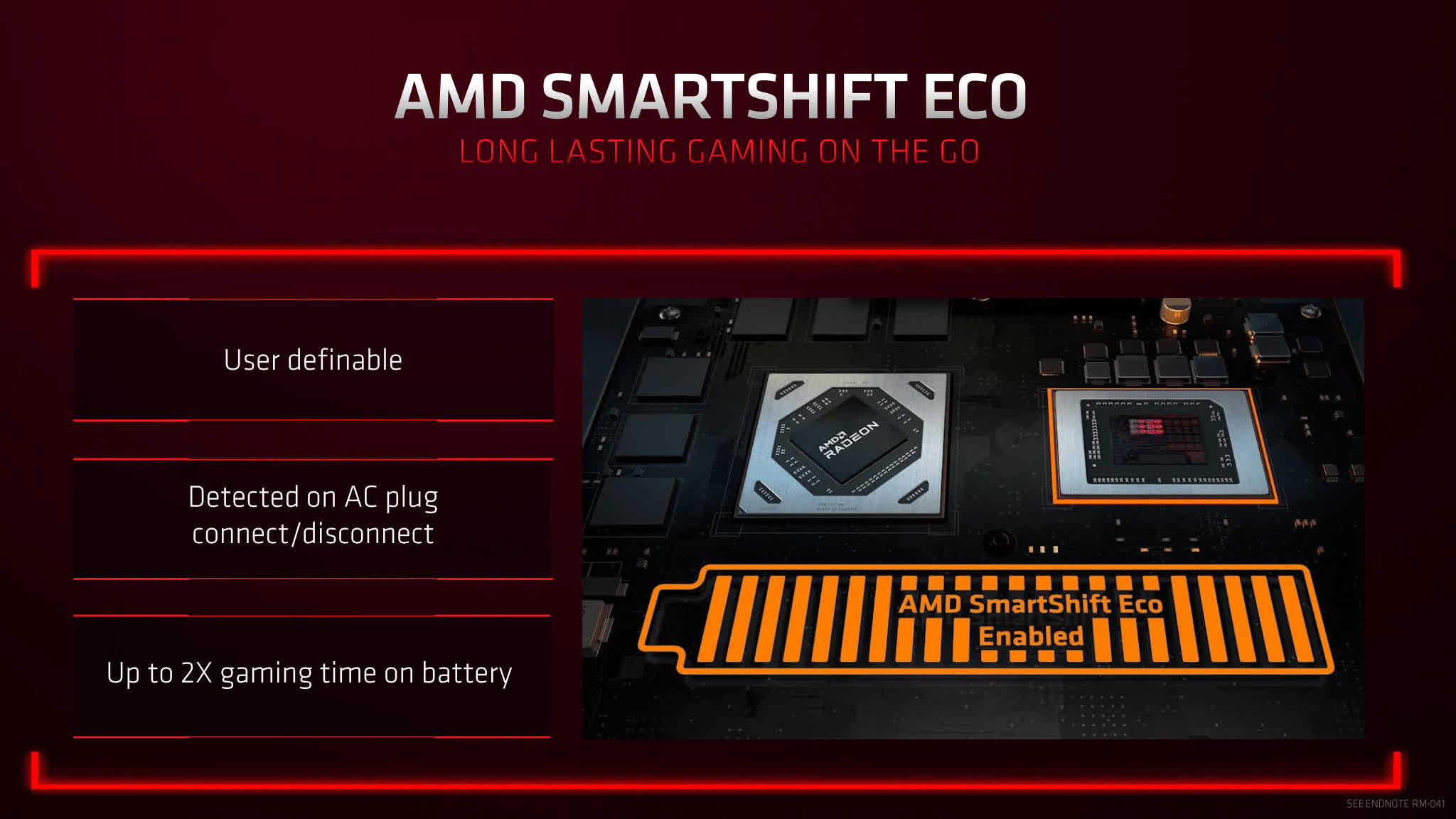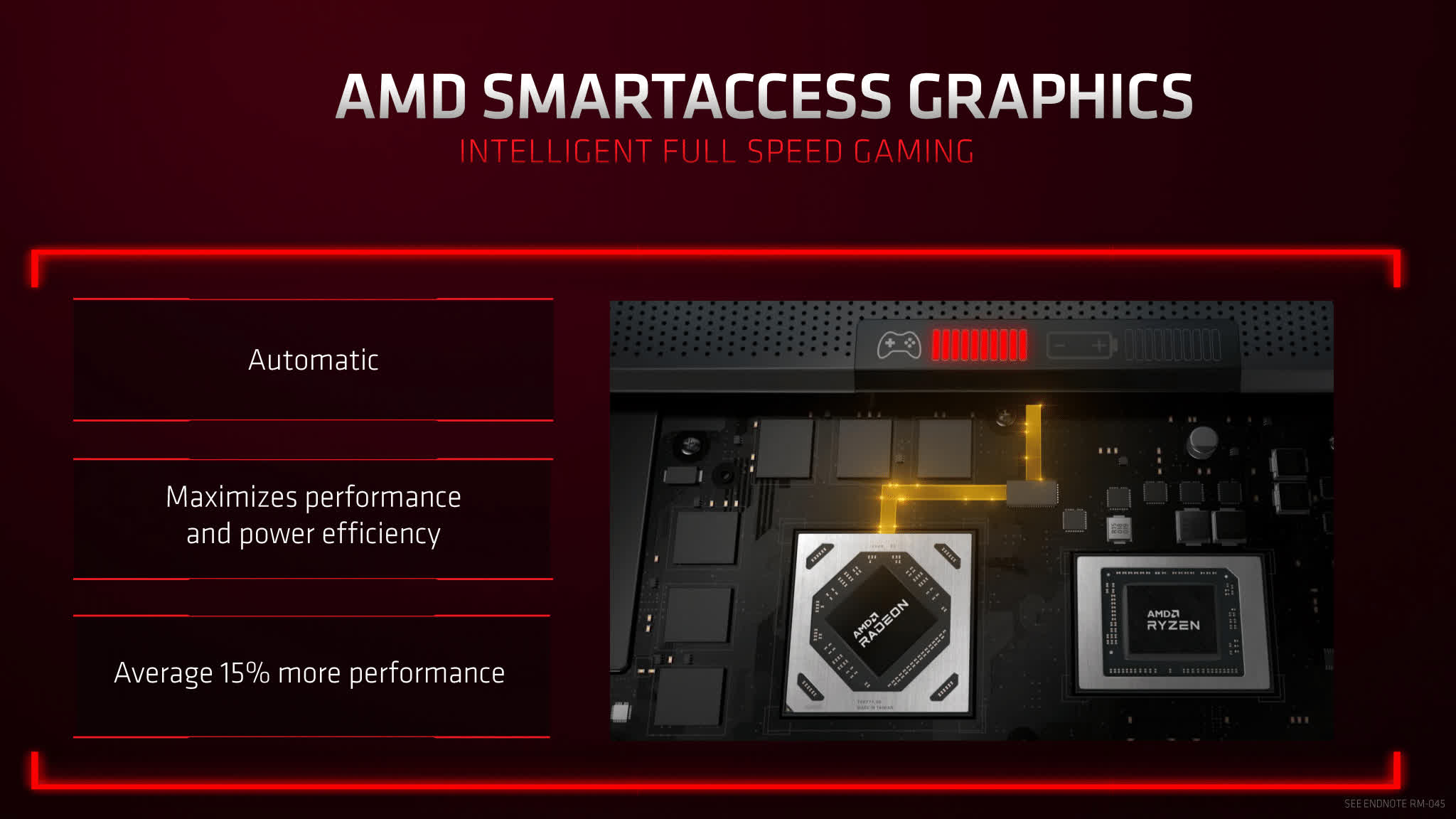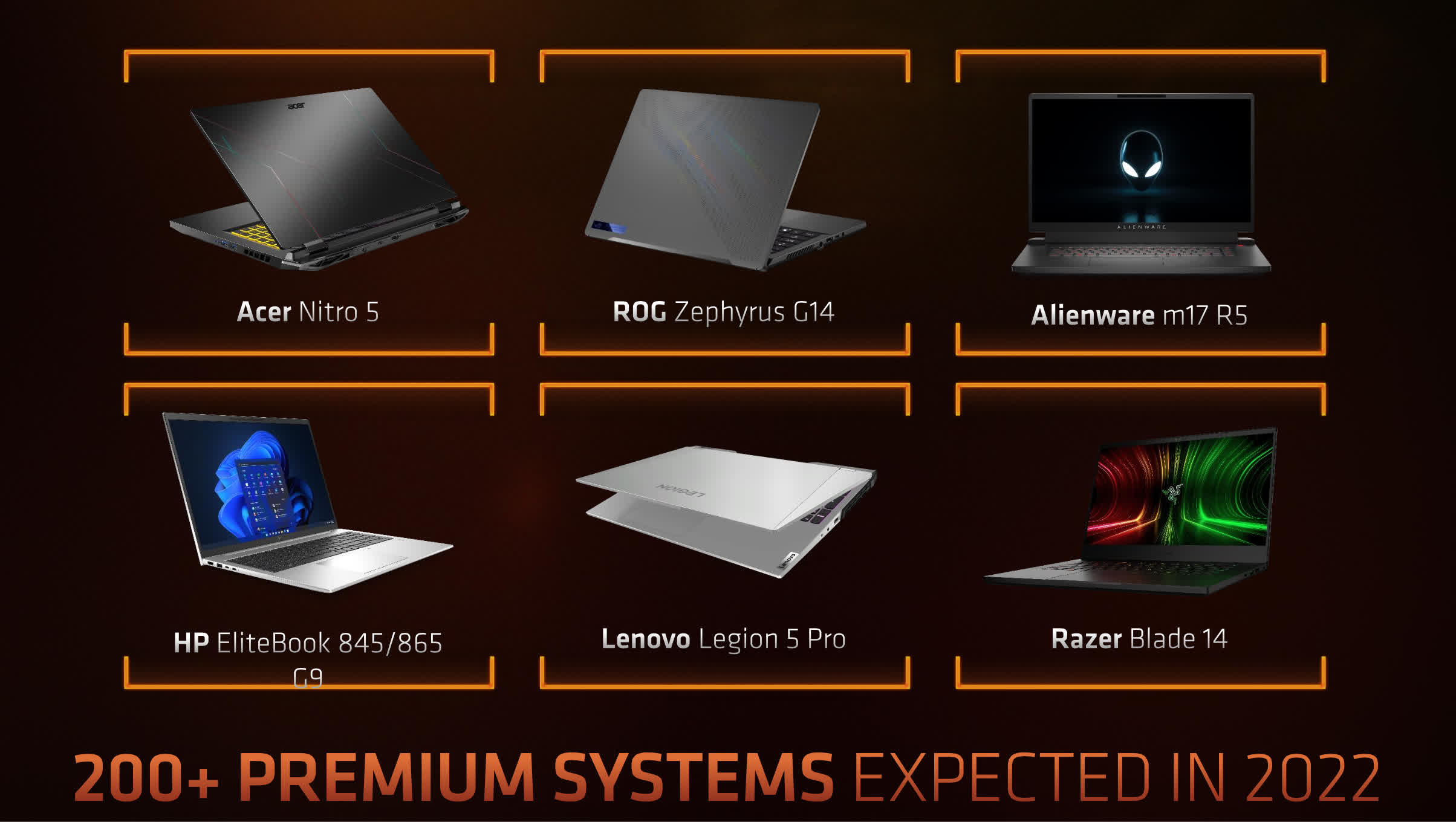What just happened? AMD’s CES 2022 event has just wrapped up and we’ve got all the information for you, condensed into a nice, neat package. Here's a recap of what was announced and our thoughts on those announcements.
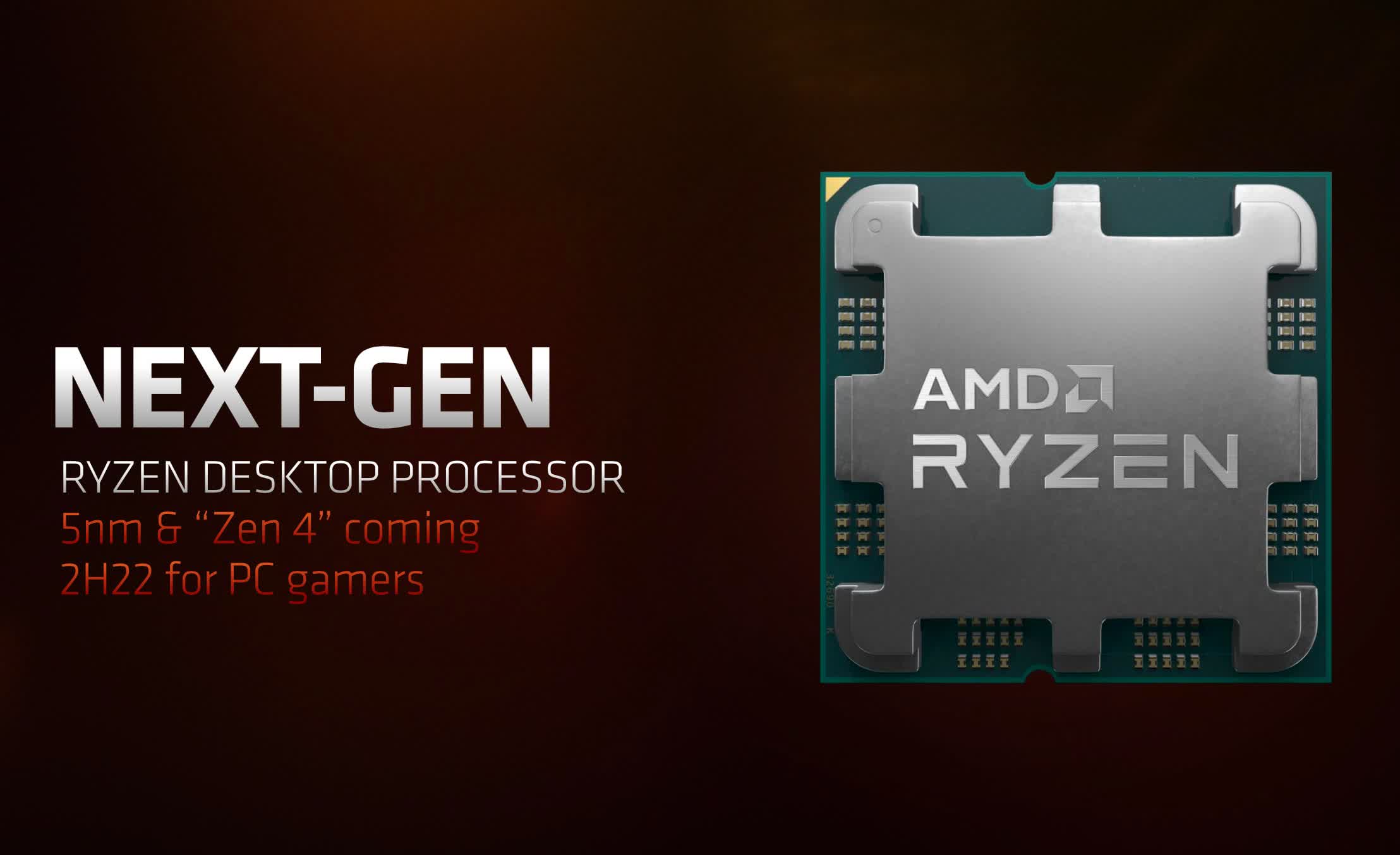
Let’s kick this off with a look at AMD’s desktop announcements and if you’re a CPU enthusiast then the big one for you will be the Ryzen 7 5800X3D, the first Zen CPU from AMD to use V-Cache 3D stacking technology.
Ryzen 7 5800X3D: AMD's new top gaming CPU
V-Cache was previewed at Computex in 2021, and it works by stacking a cache die on top of the existing 7nm Zen 3 chiplet to significantly increase the amount of L3 cache. If we zoom into this rendered image of the 5800X3D, you can see the area in the middle where this extra silicon is layered on the existing CPU, with the CPU cores at the edges.
With V-Cache, the 5800X3D goes from 32MB of L3 cache, to a total of 96MB – the original 32MB on the Zen 3 chiplet plus 64MB of V-Cache. The rest of the CPU remains essentially identical to the 5800X – it’s an 8 core, 16 thread design, it’s an AM4 chip that works on 400 and 500 series motherboards, and it has a 105W TDP. However, clock speeds are slightly lower than the regular 5800X, the base has dropped from 3.8 to 3.4 GHz, and the boost from 4.7 to 4.5 GHz. I suspect this is a combination of needing to keep the extra cache within the same power envelope, and limitations on how fast you can clock the V-Cache component.
At this stage, AMD are only saying the 5800X3D will be available in the spring and no pricing has been announced. It’s also the only consumer V-Cache chip that will be released at that time. We asked AMD whether they’d be bringing it to more CPUs but they said this is the only one – for now.
That kind of makes sense because the major benefit to V-Cache in a consumer CPU is gaming performance. Our own testing has shown repeatedly that an increase to cache capacity can noticeably boost gaming performance, and that’s what AMD is claiming as well, with a 15% average gain over the Ryzen 9 5900X, and slightly higher performance than Intel’s Core i9-12900K, enough for AMD to claim the fastest gaming processor crown in their eyes. These are just first party benchmarks though, so we’ll have to verify whether any of this is true and how much cherry picking is going on here.
Right now, the 5900X and 5950X don’t make a ton of sense for gamers, as performance isn’t any higher than the 5800X for gaming workloads. Launching the first V-Cache part as a boosted 5800X is probably the sweet spot for a premium gaming CPU.
The roadmap to Zen 4
Also on the CPU side, AMD teased upcoming products scheduled for release later this year.
Zen 4 will be coming to desktop platforms in the second half of 2022, using 5nm process technology. AMD confirmed the CPU has a different visual design as well, featuring what appears to be a larger heatspreader with different cutouts and quite an unusual design compared to the cleaner heatspreaders we’ve seen on Ryzen so far.
Alongside Zen 4 will be a new socket, unsurprisingly called socket AM5 which moves from a PGA to LGA layout, LGA 1718 to be specific. It will be compatible with existing AM4 CPU coolers, but provide substantial I/O improvements, including DDR5 and PCIe 5.0, giving AMD feature parity with Intel’s current line-up.
Hopefully by the time AM5 is released, DDR5 will be more available and more affordable (AMD gave no indication if DDR4 will be supported).
As both Zen 4 and AM5 are expected much later in 2022, details were light, but everything appears to be on track for a launch this year.
New Budget Radeon RX 6500 XT
Moving into desktop graphics, AMD announced the Radeon RX 6500 XT as a new mainstream option for gamers... if you can actually buy one, of course, which these days is not a given. This compact GPU features 16 compute units, 16 MB of infinity cache, and a 2.6 GHz game clock, so it’s essentially half of a Radeon RX 6600 XT. AMD didn’t reveal the memory subsystem specs, probably because it’s expected to be just 4GB of GDDR6 on a weak 64-bit bus.
AMD’s comparison points for the 6500 XT are the Nvidia GeForce GTX 1650 and the Radeon RX 570. AMD is saying performance should be roughly 30 to 40 percent higher than the GTX 1650, and less of a gap to the RX 570, but still a fair bit faster at 1080p. These numbers should place it around the level of an RX 580 or GTX 1650 Super. So we’ll see how that pans out in the next few weeks.
The 6500 XT will be available on January 19th at a $200 MSRP, which if we go on past GPU release trends is very likely to be a fake MSRP. We'll be really surprised if this price is maintained beyond the first batch of cards. AMD told us that availability is obviously a challenge, but should be similar to the 6600 series, which had reasonable stock.
The big question mark here is real pricing, and for that there’s a few reference points we can look at. Currently on the scalper market, the RX 6600 and RX 6600 XT are sitting at 75% inflation over the MSRP, the RX 6600 is $580 or so compared to its $330 MSRP. Then we also have AMD’s comparison points, the GTX 1650 is a $270 used GPU (up from $150 at launch), and the RX 570 4GB used goes for $230 (up from $170) – noting this new GPU is supposed to be faster. It’s also less likely to appeal to miners with its probable 4GB of VRAM and limited memory bandwidth. My estimation is that the card will go for ~$300 in the current market.
The MSRP is also pretty underwhelming all things considered, and has clearly been pushed up due to insane GPU demand. This card is probably going to be RX 580 level in performance, and that GPU launched in early 2017 for $200 in its 4GB configuration. Nearly 5 years later and it’s looking like there’s still very little movement in price to performance in the mainstream, even without factoring in AIBs, distributors and scalpers inflating the price again in the real GPU market. It’s unclear whether something like this would attract the usual mainstream buyer who already has a GPU at this level of performance, given the abundance of GTX 1060s and RX 580s in systems today.
The 6500 XT with just 16 compute units looks more like an RX 560 replacement, which was a $100 GPU back in 2017 (used cards can be found for about $150 today). At most, a $150 MSRP would feel appropriate if still high. But these days GPUs sell for well above what they “should” be priced at, and if the real price ends up being $250 or less, it will likely be better value than what you can actually buy right now.
Radeon Super Resolution: What is it?
Moving on, AMD announced Radeon Super Resolution, which is a driver-based implementation of FidelityFX Super Resolution that can be applied to any game. If you saw my recent video looking at Nvidia’s alternative feature, Nvidia Image Scaling, you know what to expect as they’re both basically doing the same thing.
RSR is unlikely to be as effective as FSR, as it will upscale the entire game including the UI, which does reduce visual quality compared to FSR as we saw with Nvidia’s NIS. But it is nice to have feature parity between GPU vendors, which we hoped would happen. RSR will be included as part of AMD’s Q1 2022 software release.
AMD Ryzen 6000 series for mobile: All-new hardware
AMD also spent a considerable portion of the event talking about new mobile products, headlined by the Ryzen 6000 series for mobile. This is a major overhaul of their APU design, bringing with it an enhanced "Zen 3+" CPU core, TSMC 6nm process technology, and RDNA2 graphics along with big changes to their platform.
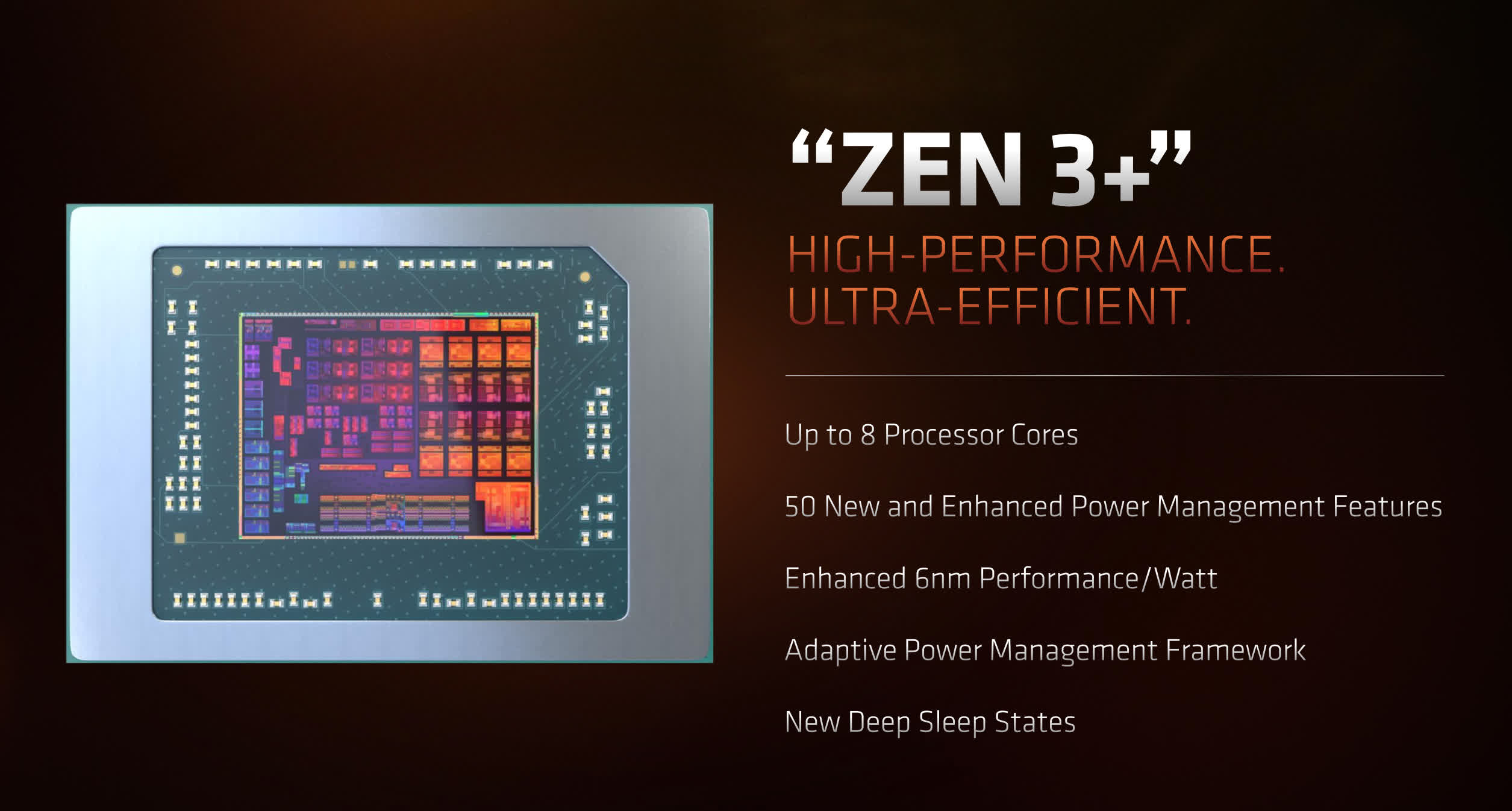
The Zen 3+ core is designed for efficiency. It’s essentially the Zen 3 design that we all know, enhanced with new power features and better power management, along with performance per watt gains brought from the shift to 6nm. Given the mobile focus, we’re unlikely to see Zen 3+ come to the desktop, unless this exact sort of APU design is released as a socketed processor.
But the CPU cores are not the stars of the show. That goes to the new RDNA2 GPU design, which features up to 12 compute units. This is the first ever APU to support ray tracing, so yes, your ultrathin laptop design using a U-series APU will be able to run ray traced games (probably at a handful of FPS).
Moving to RDNA2 is a huge overhaul compared to the Vega design in the 5000 series, it includes more cache, more render backends, a higher frequency, and thanks to other platform features, more memory bandwidth as well.
Basically everything in the platform is brand new and overhauled. DDR5 and LPDDR5 are supported, massively improving the available memory bandwidth which is key for feeding the RDNA2 GPU. AMD has finally moved up to PCIe 4.0, with 16 lanes split among the GPU, storage and other devices (previous APUs only had PCIe 3.0). USB4 is included, as is support for Wi-Fi 6E.
And in a surprise, these new APUs are DisplayPort 2 ready, as well as supporting real HDMI 2.1. The media engine has been significantly overhauled as well to improve performance and add in features like AV1 hardware decoding. All in all, this is a massive upgrade to all aspects of AMD's mobile platform which did feel a bit outdated with Ryzen 5000 mobile.
DDR5 and hitting 5GHz
About memory support... our understanding speaking to OEMs about upcoming laptop designs is that Ryzen 6000 APUs only support DDR5. However, this isn’t expected to significantly increase laptop pricing, as we’ve been told DDR5 supply to OEMs is significantly better than at retail, and pricing is only slightly higher than DDR4. Plus, it looks like most OEMs will be using some form of DDR5 for both new AMD and Intel laptops.
But there’s more, as Ryzen Mobile 6000 will be the first Ryzen CPU to hit 5 GHz – that’s the listed boost frequency of the Ryzen 9 6980HX. The 5980HX topped out at 4.8 GHz so it is just a 4% increase but it’s still one of those key milestones for a CPU architecture.
Across the rest of the line-up, boost frequencies are higher, too – the 6600H gets 4.5 GHz now versus 4.2 GHz with the 5600H – while base clocks are roughly the same for the H parts. But we do get a hint of the improved efficiency here with AMD’s HS-series APUs for 35W class systems, the base clocks have risen by up to 10 percent which should deliver greater performance. The cache system remains untouched at 16MB of L3 plus 4MB of L2 in the full 8 core parts.
Of course, there's also new ultrathin U-series processors with a TDP range of 15-28W. Alongside some refreshed 5000 series parts, there are two new U-series SKUs, the best of which is the Ryzen 7 6800U that now tops out at 4.7 GHz (up from 4.4 GHz with the 5800U) and gives us the full 12 compute unit RDNA2 GPU. That should be a real GPU beast in a portable system. The six-core designs in both the H and U series (the 6600H, 6600HS and 6600U) all feature cut down GPUs with just 6 compute units and a lower 1.9 GHz clock speed, but it’s good to see all of the 8 core models getting the full 12 CUs at either 2.2 or 2.4 GHz.
To go with a big overhaul of their offering, AMD are making some big and bold performance claims.
In the U-series, for example, AMD expects 1080p gaming performance to double with the 6800U versus 5800U in a 28W power envelope. Alongside this we should expect massive gains in any application that uses GPU acceleration or media encoding, including Adobe Premiere Pro and Blender. AMD expects the 6800U to easily beat Intel’s Core i7-1165G7 and Nvidia’s MX450 in gaming, although both of these parts will be updated in 2022 to newer designs. And with FSR enabled, AMD is touting roughly 60 FPS at 1080p in major titles like Far Cry 6 and Deathloop on the 6800U, which is impressive even if visual quality is reduced.
CPU performance wasn’t forgotten, and AMD is listing 10% higher single-thread and up to 30% higher multi-thread performance for the 6800U vs 5800U at 28W in a couple of applications. Of course, we’ll have to assess these performance claims ourselves, the usual gain of salt applies here.
But also with all the power management enhancements, AMD are expecting some designs to offer up to 24 hours of video playback on battery, with lower power consumption for that task along with others like web browsing in Chrome. Unfortunately though, we didn’t get any expected performance for the H-series APUs, so we’ll have to discover for ourselves how they stack up for high performance notebooks and gaming systems.
Ryzen 6000 laptops will be available starting in February and they will face a fair bit of competition. Intel are expected to announce new laptop processors of their own based on Alder Lake, which should be significantly faster than anything they currently offer going on how their desktop line-up performs.
So while these performance claims are nice, and the platform overhaul is much needed, 2022 is set to be a hotly contested battle in the mobile space and AMD’s key selling point will likely be their fast and new integrated GPU.
New Radeon Laptop GPUs
AMD announced the Radeon RX 6000S series, which are the regular RX 6000 GPUs optimized for thin and light laptop designs. The three offerings, the RX 6800S, RX 6700S and RX 6600S will run at lower wattages compared to their full M alternatives -- think Nvidia’s now defunct Max-Q series -- except AMD are making it more obvious with the naming scheme that these are lower power models.
On top of the S-series, AMD are releasing five new M-series GPUs for laptops. Three of these are enhanced, faster and more efficient variants of their existing line-up. AMD are claiming the RX 6850M XT should be 7% faster than the 6800M, while the RX 6650M XT and RX 6650M should be 20% faster than the RX 6600M. Then there’s two new mobile GPUs based on their Navi 24 die, the RX 6500M and RX 6300M, which are designed for entry-level laptops that typically use GPUs around the 35W mark.
We don’t have many details on these products yet, but it sounds like the performance gains are being achieved through a combination of higher GPU and higher memory clocks. The 6600M has some room to move up to 16 Gbps memory versus 14 Gbps, and AMD could also enable the full 32 CU Navi 23 die for the 6650M XT if they wanted. We’ll learn more about these closer to launch in the next few months.
For gaming laptops that use AMD discrete GPUs in 2022, several new features will be available. One is SmartShift Max, an improvement on their existing SmartShift technology that balances the power budget between the CPU and GPU while gaming, typically lowering CPU power to give more juice to the GPU. With SmartShift Max, AMD have tweaked the algorithm to work in more titles, and provide a small performance boost over SmartShift in others.
SmartShift Eco disables the discrete GPU while gaming on battery, allowing you to use the integrated RDNA2 GPU in the new 6000 series APUs instead.
And for the hardcore laptop fans out there, the final new Smart technology announced today will be very exciting: SmartAccess Graphics. This is an automatic mux switch that allows a direct connection between the display and discrete GPU while gaming, then switching over to the iGPU for efficiency when high performance graphics isn’t required.
Mux switches have become a popular feature for gaming laptops as direct GPU to display connections tend to improve performance by 10 to 15% compared to running the dGPU through the iGPU, and in the case of Nvidia GPUs allows G-Sync to work. SmartAccess Graphics will manage that switching automatically without a system reboot for AMD Advantage laptops that use both AMD CPUs and GPUs.
This is particularly cool because Nvidia’s competing "Advanced Optimus" never really took off, and OEMs told us it was hard to integrate, so hopefully AMD’s solution is more viable (and AMD claims most Advantage designs will use it).
Those are all of AMD’s key announcements in a jam-packed CES briefing. We're very keen to check out the new 5800X3D CPU to see how V-cache performs, and on the laptop side the significant platform overhaul for Ryzen Mobile 6000 and the new mobile RDNA2 GPUs are certainly going to be interesting to benchmark.
https://www.techspot.com/news/92835-amd-ces-2022-roadmap-zen-4-am5-ryzen.html
